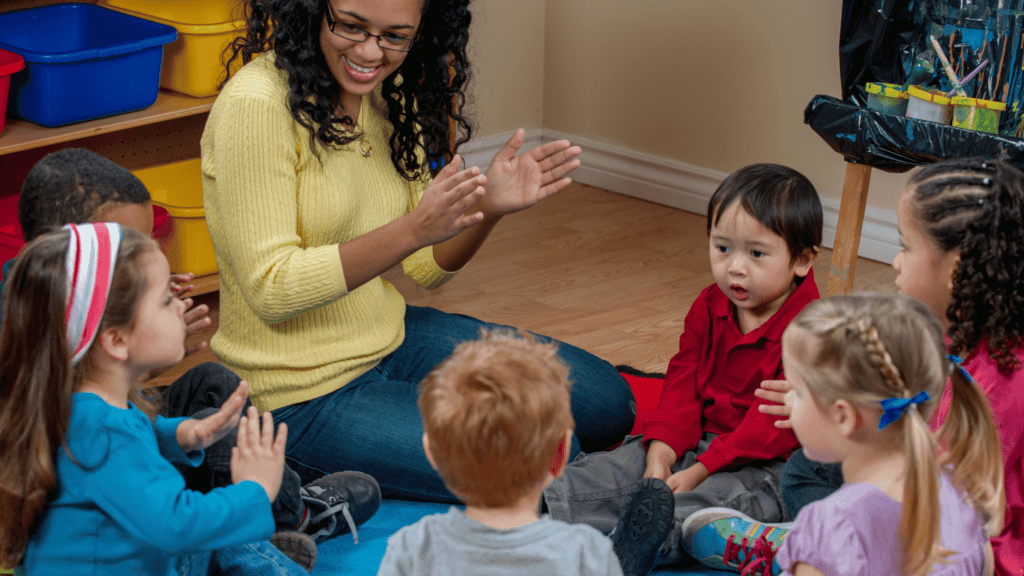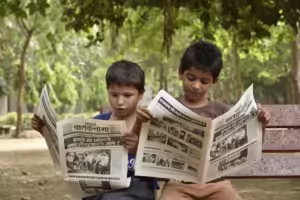Active play is crucial for preschool-aged children to learn, not only at home but especially in school. Children enjoy exploring and trying new things, but it is also important to teach them that there is a routine they need to follow in every setting.
Montessori classrooms are bustling with activity, where children engage in self-directed and teacher-led lessons. Circle Time is a critical aspect of Montessori education and an essential part of the classroom dynamic. It provides children an opportunity to participate in activities that promote social, emotional, and cognitive development. Moreover, it helps establish a sense of community within the classroom, which is a fundamental aspect of the Montessori philosophy.
What is a Circle Time in Montessori Classroom?
Circle time is a regular group meeting in the Montessori classroom where children and it typically lasts between 20 and 30 minutes and is a mixture of routines, traditions, music, movement, conversation, learning, and fun. Circle Time is a time for children to practice social skills, take turns, and develop language and communication skills with their peers and educator.
At the end of the morning, the teacher invites the class to gather in the Circle Time area using a gentle bell or chime, indicating that work time is ending. The children clean up their work and proceed to the designated area. It is one of several transitions that occur during the day, and the classroom is now prepared for lunchtime.
Some of the toddlers and primary-level children may go home and for those who stay, Afternoon Circle Time takes place. It generally takes place at the end of the afternoon work period. It also serves as a transition from our school day to aftercare time, making it a bridge between activities, and allowing children to anticipate what happens next in their day.
It also helps to develop a sense of a stronger community for the future.
Purpose of Montessori Circle Time
During Montessori circle time, children are encouraged to feel a sense of belonging to their classroom community. It also encourages children to collaborate, share ideas, and improve their communication skills. Children can practice self-control and discipline during circle time. Their skills include sitting still, listening, and taking turns speaking. Acquiring these skills is essential for success in both academic and social settings.
Why Circle Time is Important for Children?
Circle time in Montessori classrooms has several benefits, including:
- Socialization: In a supportive and inclusive environment, circle time offers children an opportunity to interact with their peers and their teacher. It helps children to develop social skills, such as taking turns, sharing, and listening to others.
- Communication: Circle time encourages children to express their feelings and thoughts. This activity helps to develop language and communication skills.
- Discipline: Circle time allows children to practice self-control and discipline. They learn to sit still, listen, and take turns speaking, which are essential skills for success in both academic and social settings.
- Building Community: In Montessori classrooms**,** circle time fosters a sense of community, an important aspect of establishing a sense of belonging. In Montessori classrooms, circle time fosters a sense of community, an important aspect of establishing a sense of belonging. This activity encourages children to work together, share ideas, and develop their communication skills.
- Preparation for Lessons: Circle time gives children the opportunity to settle in and prepare themselves for the day’s lessons. It helps them to transition from one activity to another and stay focused throughout the day.
- Improvement of listening skills: During circle time, children learn to pay attention to their peers and teacher, which helps to improve their listening skills. This translates to better comprehension and retention of information during learning concepts.
- Develops routine and transition: Circle time is a structured routine that helps children transition from one activity to another. It helps them develop a sense of responsibility and self-control and teaches them the difference between work and play. Additionally, circle time helps children develop a sense of anticipation and excitement about what’s to come next.
20 Circle Time Montessori Activities You Must Try at Home
As we have learned above, circle time is a crucial part of the Montessori method of education when children gather together to learn, share, and connect. Here are 20 Montessori circle time activities that you can try at home:
- Singing: Start your circle time by singing a song together. Setting a positive tone helps children get into the routine of the day.
- Story Time: Read a story aloud to the children. Encourage them to ask questions and discuss the story.
- Role-playing: Role-playing is a recreational activity in which participants assume the roles of fictional characters and create a story together through improvisation and interaction. It is creative, engaging, and effective, which makes it a great addition to circle time.
- Movement Game: Play a movement game such as “Simon Says” or “Red Light, Green Light.” This helps children develop gross motor skills in a fun way.
- Name Game: Play a name game to help children learn each other’s names. One child says their name and performs a motion, and the other children repeat the name and motion and add another motion while repeating the previous motion. For example, the First, child says my name is Charu and does a twist, and the second child repeats the first child’s movement, i.e. twist and then clap. The third child will twist, then clap and shake hands. The movements keep adding till the last child.
- Grace and Courtesy Lesson: Grace and courtesy lessons are also a great activity for circle time because they can be adapted to almost any subject and can be used during all groupings of children.
- Mindfulness Activities: Circle time may include mindfulness activities such as deep breathing or visualization exercises. These activities help children to develop self-awareness, self-regulation, and emotional intelligence.
- Time to put our work away: This is a signal for the children to clean up their workspaces and put away their materials. It teaches them to be responsible for their own space and helps to establish a sense of order and routine in the classroom.
- Show and Tell: Give children the opportunity to bring in an item from home and share it with the group.
- Fingerplays: Teach Finger plays such as “Itsy Bitsy Spider” or “Five Little Ducks.”
- Yoga: Teach simple yoga poses to help children with focus and relaxation. These activities promote physical development and help children release energy, refocusing their attention.
- Rhyming Game: Play a rhyming game where one child says a word and the others have to come up with a word that rhymes.
- Guide the blindfolded: One child is blindfolded, and another child guides them around the room using verbal instructions. This activity helps to develop listening and communication skills.
- Nature Walk: Take a nature walk and have children observe and collect items such as leaves or rocks.
- Gratitude Circle: End your circle time by sharing something that you are grateful for and reflecting on the positive aspects of the day.
- Emotions Chart: Use an emotion chart to help children identify and express their feelings. Ask them to narrate an incident with the same emotion.
- Puzzles: Provide puzzles for children to work on together or individually.
- Group discussion: Montessori circle time often includes a group discussion or sharing activity. Children may take turns talking about their weekend, sharing something they are proud of, or discussing a topic related to the curriculum. This activity helps to build communication skills and encourages active listening.
- Greetings activity: Begin circle time with a greeting activity that helps to create a positive atmosphere and sets the tone for the day. Children may greet each other by name, or participate in a group handshake or high-five.
- Learning through group lessons: Geography and science lessons are conducive to conversation, and Circle Time is the perfect opportunity to start the discussion. While a teacher might present a new lesson or introduce a new topic, much of the learning occurs during the follow-up conversation.
- Movement Breaks: During circle time, children can participate in movement breaks to release energy and refocus their attention. These breaks can include simple exercises like jumping jacks or stretches to help children stay alert and engaged throughout the day.
Montessori circle time activities are designed to be interactive, enjoyable, and beneficial for children. They encourage the development of social skills, cognitive growth, and language. You can try these activities at home and witness your child’s passion for learning to flourish.



